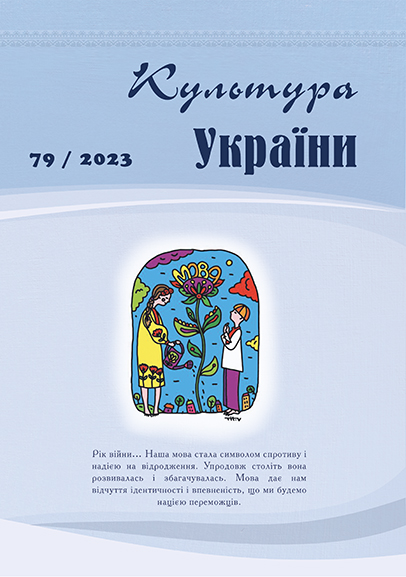До питання становлення та розвитку анімаційної індустрії у ХХ — на початку ХХІ століття
DOI:
https://doi.org/10.31516/2410-5325.079.04Ключові слова:
анімаційна індустрія, CGI-анімація, США, технологічний розвиток, 2D, 3D, голлівудська системаАнотація
Проаналізовано передумови та динаміку розвитку анімаційної індустрії впродовж ХХ — на початку ХХІ ст. З’ясовано, що індустрія анімації зародилась у США під впливом кінематографу, пройшла складний шлях розвитку в коеволюції з кіноіндустрією, пережила глобалізацію виробництва. Відзначено, що її подальше становлення було детерміноване двома основними факторами: технологічним розвитком, який уможливив диверсифіковані ринки та продукти, поліпшив здатність аніматорів висловлювати власні творчі ідеї, крім того, сприяв розширенню глобального ринку та багатьох регіональних ринкових ніш, а також зниженню собівартості виробництва, що забезпечило базові умови для створення анімації в інших країнах-субпідрядниках. Доведено, що в 1980-х рр., після майже десятиліть перерви, знову активно почали знімати 2D-анімаційні фільми для кінотеатрів, сформувалися локально-ремісничий стиль і глобалізована голлівудська система в рамках анімаційної індустрії.
Посилання
Anime subculture in the youth environment: information notes from the series “Panorama of the World” (2017). N. O. Klimenko (Compiler). MI KRC “KOBIU”. [In Ukrainian].
Alderson, A. & Beckfield, J. (2004). Power and position in the world city system. American Journal of Sociology, 109(4), 811–851. [In English].
Barrier, M. (1999). Hollywood Cartoons: American Animation in its Golden Age. Oxford University Press. [In English].
Bendazzi, G. (1994). Cartoons: One Hundred Years of Cinema Animation. Indiana University Press. [In English].
Bryman, A. (2000). Telling technological tales. Organization, 7(3), 455–475. [In English].
Buchan, S. (2013). Pervasive Animation. Routledge. [In English].
Crawford, A. (2003). The digital turn: animation in the age of information technologies. In Prime-Time Animation: Television Animation and American Culture, 110–130. C. Stabile and M. Harrison (Editors). Routledge. [In English].
Dixon, D. P. & Zonn, L. E. (2004). Film networks and the place(s) of technology. In Geography and Technology, 243–266. S. Brunn, S. Cutter and J. W. Harrington (Editors). Kluwer Academic Publishers. [In English].
Heller, S. (2019). Below-the-line creativity and authorship in animation: the reality of animation production. Revue Française Des Sciences de l’information et de La Communication, 18. OpenEdition Journals. https://journals.openedition.org/rfsic/8071#abstract. [In English].
Hyejin Yoon, M. A. (2008). The animation industry: technological changes, production challenges, and global shifts. [Thesis, Doctor of Philosophy, Ohio State University]. [In English].
Johns, J. (2006). Video games production networks: value capture, power relations and embeddedness. Journal of Economic Geography, 6(2), 151–180. [In English].
Jones, A. & Oliff, J. (2007). Thinking Animation: Bridging the gap between 2D and CG. Thompson Course Technology TTP. [In English].
Kao, P. (2019). Development and design of animation derivatives based on users’ perceptual needs. Fash. Color, 12, 43–44. [In English].
Liu, K. & Sun, X. Q. (2020). Research on the Development and Innovation of Animation Industry in Jilin Province in the Internet Big Data Era. International Conference on New Energy and Sustainable Development. IOP Conf. Series: Earth and Environmental Science 619. IOPscience. https://iopscience.iop.org/article/10.1088/1755-1315/619/1/012073/pdf. [In English].
McLaughlin, D. (2001). A Rather Incomplete but still Fascinating History of Animation. https://silo.tips/download/a-rather-incomplete-but-still-fascinating-history-of-animation-by-dan-mclaughlin. [In English].
Mieizas, S. J. & Kuperman, J. C. (2000). The community dynamics of entrepreneurship: the birth of the American film industry, 1895–1929. Journal of Business Venturing, 16(3), 209–233. [In English].
Muharam, N. B., & Sidli, N. A. R. B. A. (2020). Rubber Hose Animation: The Exploration towards the History and Understanding of Animation Industry. International Journal of Academic Research in Business and Social Sciences, 10(12), 575–582. [In English].
Reinke, S. (2005). The World is a Cartoon: Stray Notes on Animation. In The Sharpest Point: Animation at the end of Cinema, 9–25. XYZ Books. [In English].
Scott, A. J. (2005). On Hollywood. Princeton University Press. [In English].
Solomon, C. (1989). Enchanted Drawings. Alfred A. Knopf. [In English].
Storper, M. & Christopherson, S. (1987). Flexible specialization and regional industrial agglomerations: The case of the U.S. motion picture industry. Annals of the American Geographers, 77(1), 104–117. [In English].
Summers, S. (2020). DreamWorks Animation: Intertextuality and Aesthetics in Shrek and Beyond. Palgrave Macmillan. [In English].
Turquety, B. (2014). Inventing Cinema: Machines, Gestures, and Media History. T. Barnard (Trans.). Amsterdam University Press. [In English].
Wright, J. A. (2005). Animation Writing and Development: From Script Development to Pitch. Focal Press. [In English].
##submission.downloads##
Опубліковано
Номер
Розділ
Ліцензія

Ця робота ліцензується відповідно до Creative Commons Attribution-NonCommercial-ShareAlike 4.0 International License.
Автори, які публікуються у цьому журналі, погоджуються з наступними умовами:
У разі публікації статті в журналі «Культура України», автори зберігають авторське право, а також надають право журналу публікувати оригінальні наукові статті, що містять результати експериментальних і теоретичних досліджень і не знаходяться на розгляді для опублікування в інших віданнях. Всі матеріали поширюється на умовах ліцензії Creative Commons Attribution-NonCommercial-ShareAlike (BY-NC-SA), яка дозволяє першу публікацію в цьому журналі, а також розповсюдження роботи з визнанням авторства цієї роботи, на тих самих умовах, з некомерційною метою.
Автори мають підписати заяву, яка є угодою про надання прав редакції на публікацію статті в друкованому та електронному вигляді. Заява надсилається на поштову (оригінал) або електронну адресу (сканована копія) Редакції журналу.
Автори мають право укладати самостійні додаткові угоди щодо неексклюзивного розповсюдження роботи у тому вигляді, в якому вона була опублікована цим журналом (наприклад, розміщувати роботу в електронному сховищі установи або публікувати у складі монографії), за умови збереження посилання на першу публікацію роботи у цьому журналі.
Під час подачі рукопису статті для опублікування у збірнику «Культура України» автори погоджуються з тим, що, у разі прийняття статті до публікації, її можна буде розмістити в електронних архівах та базах даних з обов'язковим зазначенням авторства і збереженням авторських прав у повному обсязі за авторами. У тексті самої роботи мають бути в повному обсязі представлені джерела зовнішньої інформації – у вигляді списків джерел літератури (у т.ч. особисті раніше опубліковані роботи авторів). Автори рукопису статті зобов'язані належно оформляти запозичення у вигляді цитат або посилань. Будь-які форми плагіату неприпустимі.


